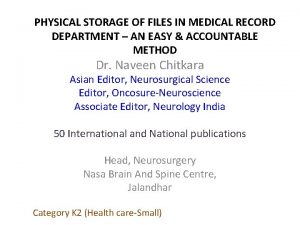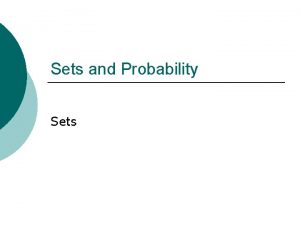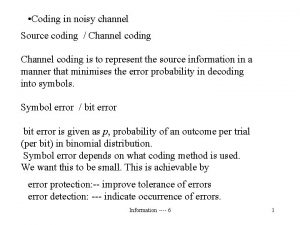THE MEDICAL CODING SYSTEM The coding sets and











- Slides: 11

THE MEDICAL CODING SYSTEM The coding sets and how to accurately utilize them for appropriate reimbursement. By: Samantha Muncy

What is Medical Coding? � Medical Coding is the process of converting medical diagnosis, procedures, services, and equipment rendered and used into universal medical alphanumeric codes Medical Coding is used for the purpose of making sure that the provider or physician is properly reimbursed for their services. All the diagnosis and procedures included in any patient encounter that are taken from the patients medical record are converted into one of the medical coding sets. (CMS, 2018) �The coding sets are as follows: �ICD-10 -CM (Diagnostic Codes) and ICD-10 -PCS (Procedural Codes) �CPT and HCPCS level 1 and level 2 codes

Coding Sets and What They Mean…. ICD-10 -CM and ICD-10 -PCS: ●ICD-10 -CM: International Classification of Diseases, 10 th Revision, Clinical Modification -Diagnostic codes are used by all providers and physicians in general for reporting diagnosis on medical claims for reimbursement purposes. -Developed and maintained by The Center for Disease Control and Prevention. -3 -7 characters long, allowing for expansion of description. -character 1= alpha -character 2 -3= numeric -character 4 -7= both alpha and numeric ●ICD-10 -PCS: International Classification of Diseases, 10 th Revision, Procedural Coding System -Procedural Codes are used only in the hospital inpatient setting for the purpose of reporting procedures or rendered services on medical claims for the purpose of reimbursement. -Developed and maintained by the Center for Medicare and Medicaid Services. -7 alphanumeric characters in length. (CMS, 2018)

Coding Sets and What They Mean Continued… CPT Codes: Current Procedural Terminology *These are HCPCS level 1 codes and their modifiers and they are used to report procedures or services in the outpatient setting. *Developed and maintained by The American Medical Association. * 5 characters and all alphanumeric, sequences of alphabetical characters and numeric characters depend on category of the code. (CMS, 2018)

Coding Sets and What They Mean Continued… HCPCS level 1 & 2 Codes: Healthcare Common Procedure Coding System *Level 1: Cpt codes and modifiers used to report procedures or services in outpatient settings. Developed and maintained by AMA. *Level 2: These codes represent procedures or services not included in the CPT codes that also take place in the outpatient setting. *Developed by CMS (Center for Medicare and Medicare Services). *5 alphanumeric characters in length. (CMS, 2018)

Impact of Incorrect Coding in Healthcare Ø For the patient it could possibly mean that the medically necessary test, procedure, or treatment will be denied and not covered by insurance and the patient will have to pay for the services out of pocket, which they may not be capable of doing. Ø For the physician , if he or she is looking at the electronic medical record instead of the physician documentation they may be mislead about the patients current condition and move forward with a treatment plan or procedure or even medication that could have adverse effects to the patient. Ø For the facility or practice if improper coding is something that is frequent then they could be found guilty of medical fraud.

Scenarios #1. Hospital Inpatient Patient was seen in the ER with complaint of back pain and nausea. Doctor ran blood tests and diagnosed the patient with severe sepsis from an unspecified location. The patient was admitted to the hospital for 24 hrs. for observation following intravenous antibiotics. Diagnosis: Sepsis of blood. Infection of Gallbladder. Procedure: Blood work and antibiotics via IV Diagnostic Code: (ICD-10 -CM) A 41. 9 Procedural Code: (ICD-10 -PCS) G 8711 #2. Hospital Outpatient Patient visited the ER with complaint of nausea, vomiting and flu like symptoms. Doctor diagnosed her with pneumonia and patient was given breathing treatment and prescribed cold medicines. Diagnosis: Pneumonia Procedure: Breathing Treatment Diagnostic Code: (ICD-10 -CM) 51608 Procedural Code: (HCPCS) E 0560 #3. Physician Office Visit Patient was seen for restless leg syndrome. Doctor recommended potassium supplements over the counter from a local drug store after doing an x-ray of lower extremities ruling out other injury. Diagnosis: Restless leg syndrome. Procedure: X-ray Diagnostic code: G 25. 81 Procedural Code: 73590

References CMS. (2018). ICD-10 -CM, ICD-10 -PCS, CPT, AND HCPCS CODE SETS. Retrieved from the Medicare Learning Network website: https: //www. cms. gov/Outreach-and-Education/Medicare-Learning. Network-MLN/MLNProducts/Downloads/ICD 9 -10 CM-ICD 10 PCS-CPT-HCPCS-Code-Sets-Educational -Tool-ICN 900943. pdf Merem Healthcare Solutions. (2018). The Consequences of Coding Errors. Retrieved from https: //www. meremhealth. com/medical-billing-services-the-consequence-of-medical-billing-error Medical Practice Management Resources, Inc. (2017). The Five Negative Effects of Medical Coding and Billing Errors. Retrieved from https: //www. medpmr. com/2015/05/16/the-five-negative-effects-ofmedical-coding-and-billing-errors/

Voice Over Script Slide one: The medical coding system is used to ensure that healthcare providers and patients are appropriately reimbursed and have the appropriate medical coverage depending upon the insurance they receive at the time of the encounter Slide two: The coding systems are used to convert diagnostics and procedures or services taken during the patient encounter and recorded into the electronic health record into universal medical alphanumerical codes. The main coding systems used ate ICD-10 -CM, ICD-10 -PCS, CPT, and HCPCS level 1 and 2 coding systems. Slide three: The ICD-10 is divided up into 2 separate coding systems and they are ICD-10 -CM and ICD-10 -PCS which stands for the international classification of disease, 10 th revision, and then its either CM for clinical modification or PCS for procedural coding system. ICD-10 -CM are diagnostic codes developed and maintained by The Center for Medicaid and Medicare Services and ICD-10 -PCS are procedural codes which are also developed and maintained by AMA but those are only used in inpatient hospital healthcare settings. ICD-10 -CM is 3 -7 characters long and ICD-10 -PCS codes are 7 characters long. Slide four: The CPT coding system is composed of HCPCS level 1 codes and their modifiers used in the outpatient hospital setting. This system is developed and maintained by the American Medical Association and they are five characters in length and are alphanumerical.

Slide five: The HCPCS level 1 and level 2 coding systems were developed and maintained by The Centers of Disease Control and Prevention and HCPCS stands for Healthcare Common Procedure Coding System and is divided into 2 sections , and they're either level one and level two. Level one is the CPT codes and their modifiers. These codes are only used for reporting purposes in the outpatient settings of a healthcare facility. Leve l 2 codes are just the codes and addon notes that are not located in the CPT coding system. This system was also developed and maintained by The Centers or Medicaid and Medicare Services. These codes are 5 digits in length and are alphanumerical in their structure. Slide 6: The Impact of improper coding effects the facility, the provider, the insurance company, and the patient. For the provider it is essential that the codes assigned are correct because if not then they run the risk of not getting appropriately reimbursed for services. The patient may find that he or she needs medically necessary treatment and services that they end of having to self-pay for because the encounter was coded improperly. Plus, if the physician is getting all of his codes on the patients condition form the EHR and not from his own documentation he could be mislead to think or believe hat the patient in question has a different diagnosis than what they have and this means that the provider may prescribe the wrong medicines or have a patient undergo unnecessary tests and lab work.

Slide 7 is contains 3 different scenarios that correspond with hospital inpatient settings that all three contain a diagnostic code a procedural code and then the correct codes are listed under the scenarios as well. After my example scenario page I have a reference page and those references are sited within the Power. Point. Thank you, Samantha Muncy Rough Draft PPT
 Apa itu selective
Apa itu selective Contoh selective coding
Contoh selective coding Coding dna and non coding dna
Coding dna and non coding dna History of qualitative research
History of qualitative research Ikya medical coding
Ikya medical coding Terminal digit filing
Terminal digit filing Hepburn osteometric board
Hepburn osteometric board Image sets
Image sets Milady chapter 18 review questions and answers
Milady chapter 18 review questions and answers Harmonised commodity description and coding system
Harmonised commodity description and coding system Ptal california medical board
Ptal california medical board Gbmc medical records
Gbmc medical records




















